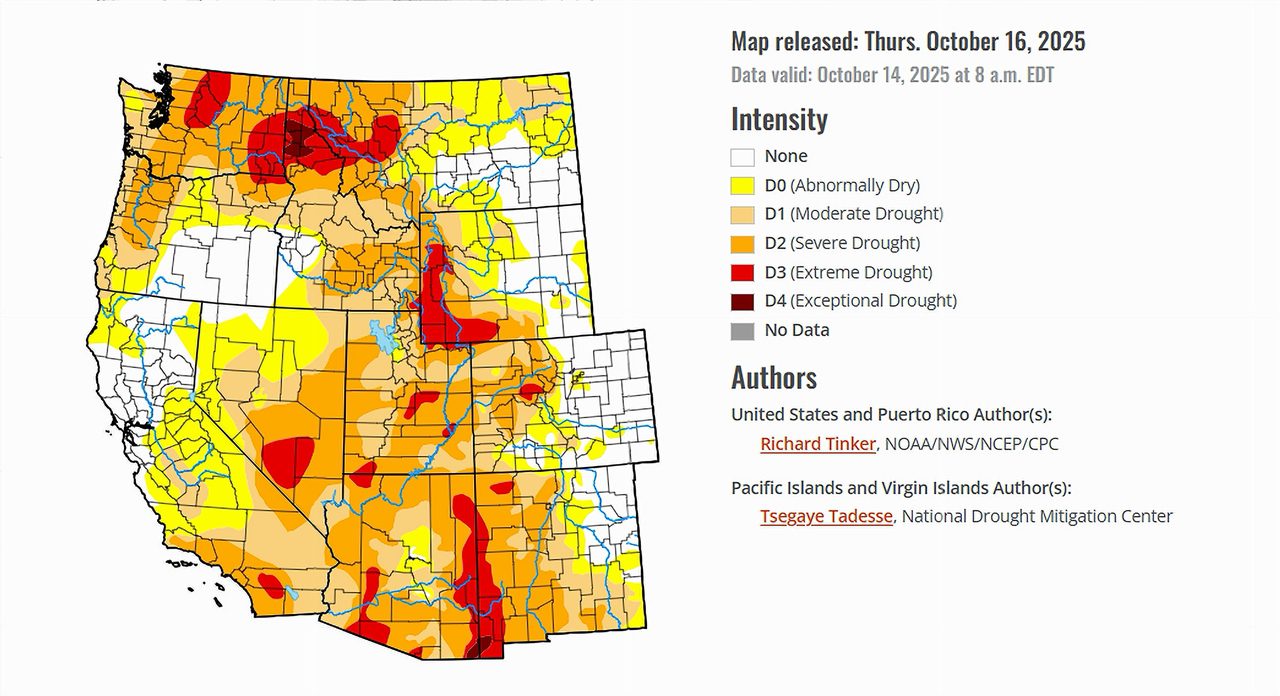- Tropical moisture eased drought in Arizona, Colorado, and Utah.
- Some areas received over six inches of rain, reducing drought intensity.
- Dryness persisted in the Great Basin and northern Plains.
- Despite a federal shutdown, the Drought Monitor remains on schedule.
Saturday, October 18, 2025 — A late-season surge of tropical moisture drenched much of the Four Corners region, easing drought conditions in parts of the Colorado River Basin. The U.S. Drought Monitor released its latest report on October 16, 2025 , noting widespread rainfall and dramatic local improvements.
, noting widespread rainfall and dramatic local improvements.
The report emphasized that “despite the federal government shutdown, the U.S. Drought Monitor map and its associated products remain unaffected and will continue to be released on schedule.”
Heavy rains brought measurable relief to many western watersheds, particularly in Arizona, Colorado, and Utah, where multiple drought categories improved. Yet even with these gains, parts of the basin continue to face long-term deficits that keep reservoirs and groundwater under pressure.
Arizona and New Mexico: From Dust to Downpour.
Arizona saw one of its wettest weeks of the year. Interior sections of the state received between four and six inches of rain, with isolated higher totals. The moisture came from late-season tropical systems pushing inland, producing flash floods in some areas but also significant drought improvement.
The Drought Monitor reported that “drought designations improved by multiple categories in some of the wetter areas across interior Arizona and southern Colorado.” Much of western New Mexico also benefited, particularly along the Mogollon Rim and the state’s northwest plateau.
Colorado: High Elevations Soak It In.
In Colorado, the higher elevations were pounded by three to eight inches of rain, with the heaviest totals falling in the south-central mountains. These rains led to “widespread improvements, with some of the wetter areas noting two-category improvements.”
Elsewhere in the state, lighter rains fell over the eastern plains, helping to stabilize soil moisture and reduce wildfire danger heading into late autumn.
Utah: Widespread Improvement.
Utah also saw clear progress, especially across central and western regions, which had been parched for much of the summer. The influx of tropical moisture improved both short-term and long-term drought indicators, though parts of northern Utah—including the Great Salt Lake Basin—remain drier than normal.
Nevada and Wyoming: Mixed Conditions.
In Nevada, rainfall was limited mostly to the eastern border areas, with much of the state remaining dry. The drought status was largely unchanged. Similarly, Wyoming recorded moderate rainfall in isolated areas but saw “significant areas of dryness development or deterioration limited to eastern Kansas and the southern tier of South Dakota,” suggesting Wyoming’s overall situation held steady.
California: Waiting for the Next Storm.
Most of California remained dry, with “only a few tenths of an inch, at most,” falling across the southern deserts and interior valleys. Although northern parts of the state may see relief in the coming week, conditions remained largely static in mid-October.
Looking ahead, the Climate Prediction Center’s 6–10 day outlook favors “heavier than normal precipitation across central and northern California, northwestern Nevada, and the Pacific Northwest.”
Overall U.S. Picture.
Nationally, drought improved in much of the Southwest and eastern seaboard, while it worsened across parts of the Deep South and the Great Plains. Eastern South Carolina saw up to a foot of rain, while parts of Georgia, Alabama, and the Florida Panhandle slid deeper into extreme drought.
In the Midwest, storms brought temporary relief to Kentucky and Ohio but left Missouri, Illinois, and Iowa struggling with precipitation deficits up to eight inches below normal over the past two months.
The Outlook.
Between October 15 and 20, forecasters expect another round of heavy rain in parts of the Pacific Northwest and eastern Montana, with moderate rainfall predicted across the Ohio Valley and Gulf Coast. Temperatures are expected to run below normal west of the Rockies and above normal from Texas to the East Coast.
For the drought-stricken Colorado River Basin, October’s storms have offered a much-needed reprieve—but sustained wet seasons will be necessary to reverse years of depletion in groundwater and reservoirs.




